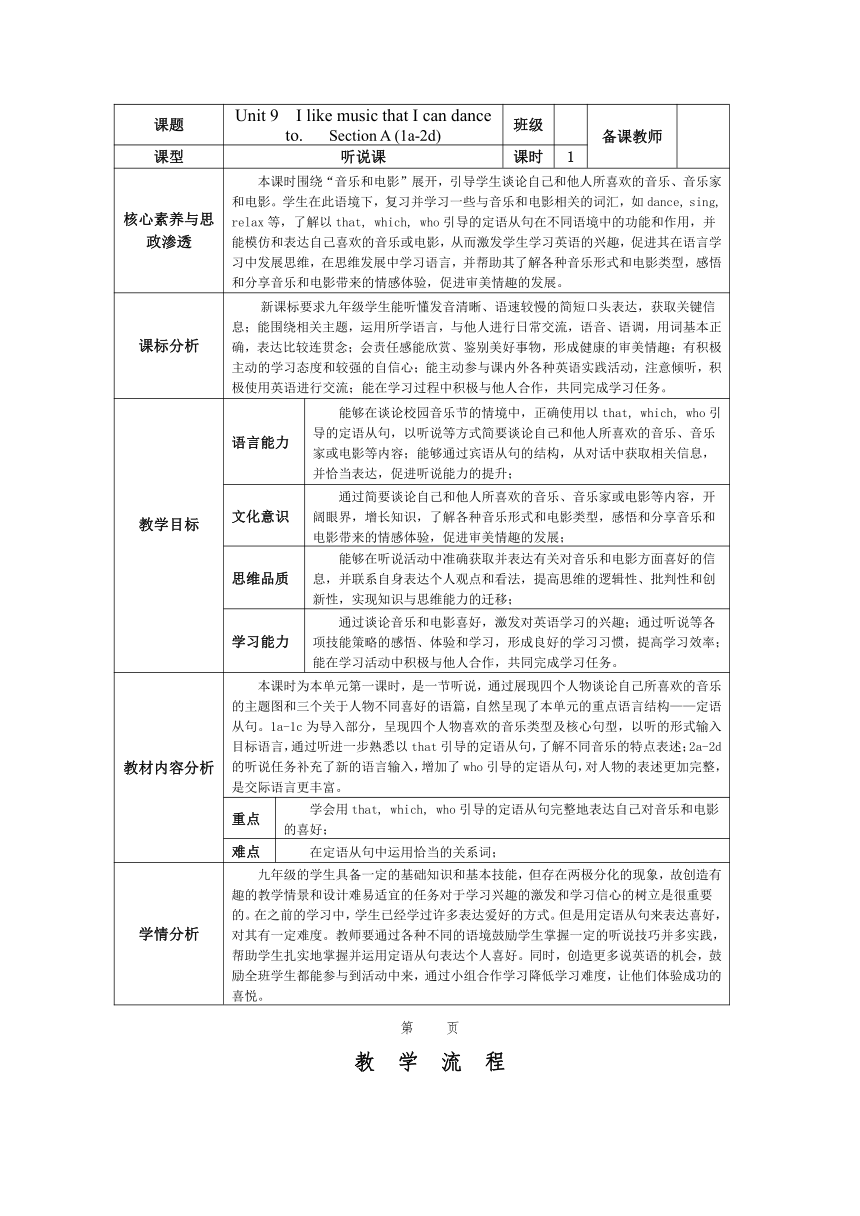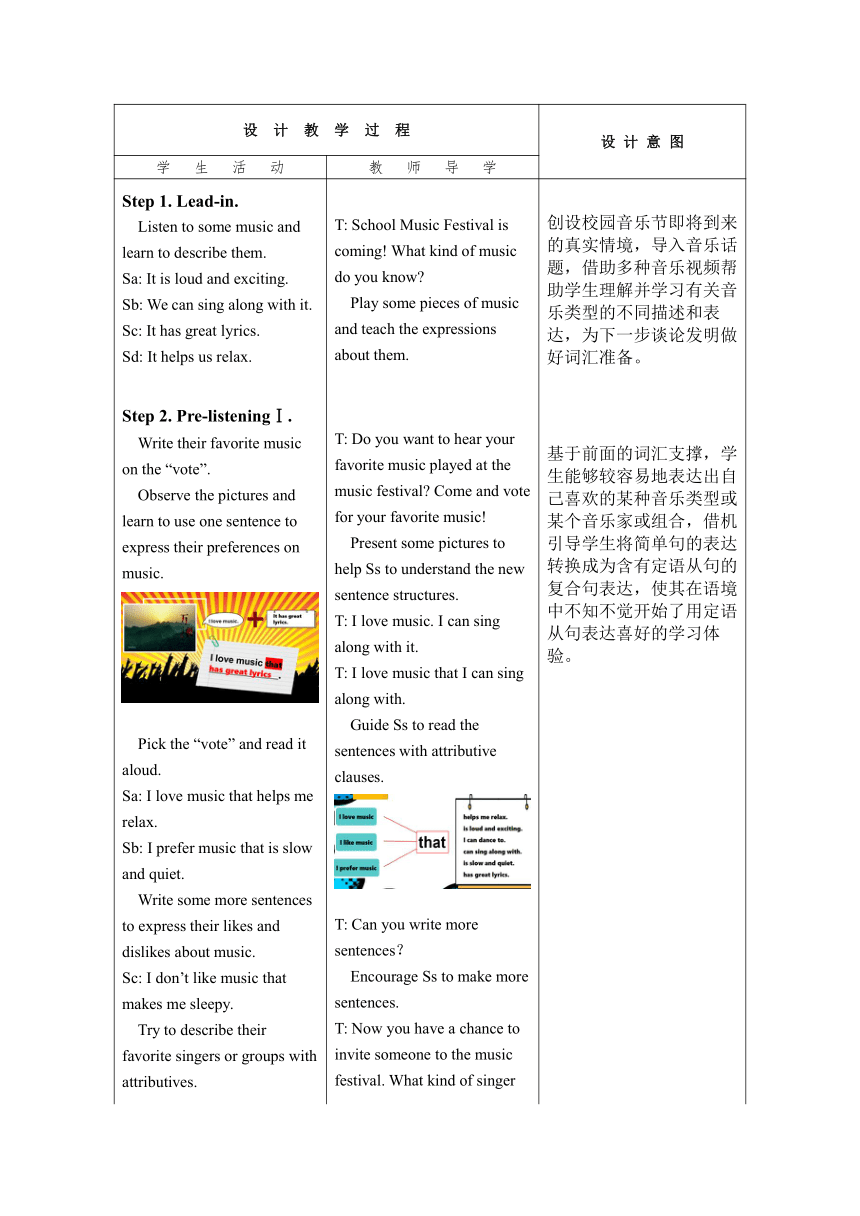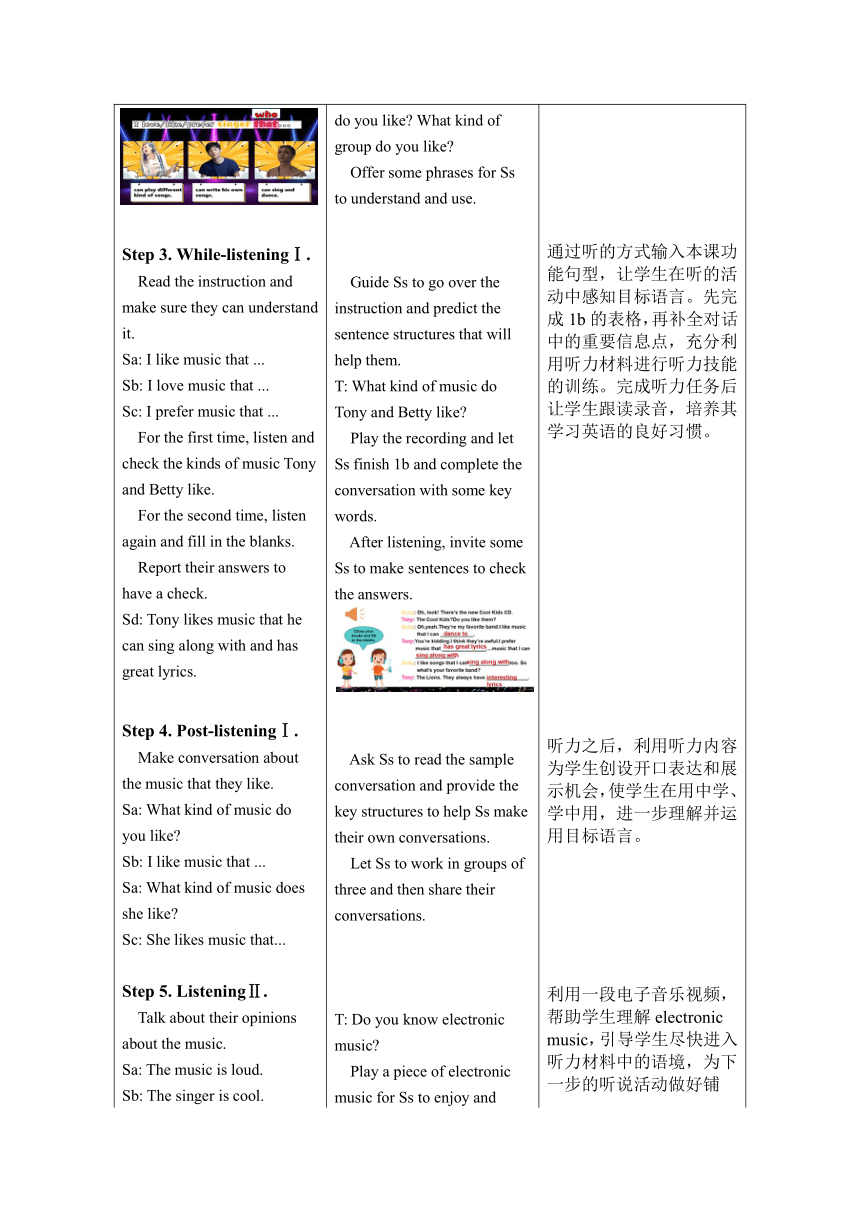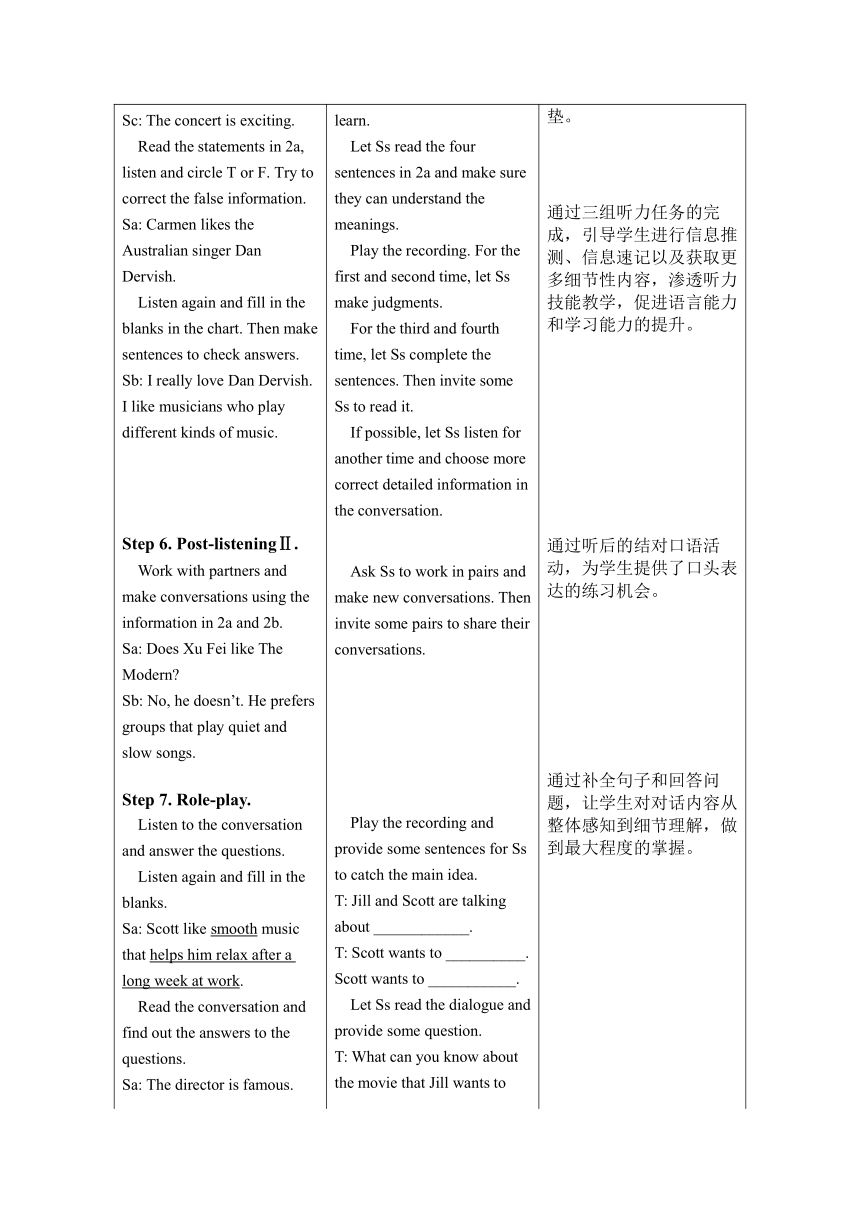【核心素养目标】Unit 9 I like music that I can dance to. Section A (1a-2d) 表格式教案
文档属性
| 名称 | 【核心素养目标】Unit 9 I like music that I can dance to. Section A (1a-2d) 表格式教案 |  | |
| 格式 | docx | ||
| 文件大小 | 583.5KB | ||
| 资源类型 | 教案 | ||
| 版本资源 | 人教新目标(Go for it)版 | ||
| 科目 | 英语 | ||
| 更新时间 | 2024-09-24 14:39:30 | ||
图片预览




文档简介
课题 Unit 9 I like music that I can dance to. Section A (1a-2d) 班级 备课教师
课型 听说课 课时 1
核心素养与思政渗透 本课时围绕“音乐和电影”展开,引导学生谈论自己和他人所喜欢的音乐、音乐家和电影。学生在此语境下,复习并学习一些与音乐和电影相关的词汇,如dance, sing, relax等,了解以that, which, who引导的定语从句在不同语境中的功能和作用,并能模仿和表达自己喜欢的音乐或电影,从而激发学生学习英语的兴趣,促进其在语言学习中发展思维,在思维发展中学习语言,并帮助其了解各种音乐形式和电影类型,感悟和分享音乐和电影带来的情感体验,促进审美情趣的发展。
课标分析 新课标要求九年级学生能听懂发音清晰、语速较慢的简短口头表达,获取关键信息;能围绕相关主题,运用所学语言,与他人进行日常交流,语音、语调,用词基本正确,表达比较连贯念;会责任感能欣赏、鉴别美好事物,形成健康的审美情趣;有积极主动的学习态度和较强的自信心;能主动参与课内外各种英语实践活动,注意倾听,积极使用英语进行交流;能在学习过程中积极与他人合作,共同完成学习任务。
教学目标 语言能力 能够在谈论校园音乐节的情境中,正确使用以that, which, who引导的定语从句,以听说等方式简要谈论自己和他人所喜欢的音乐、音乐家或电影等内容;能够通过宾语从句的结构,从对话中获取相关信息,并恰当表达,促进听说能力的提升;
文化意识 通过简要谈论自己和他人所喜欢的音乐、音乐家或电影等内容,开阔眼界,增长知识,了解各种音乐形式和电影类型,感悟和分享音乐和电影带来的情感体验,促进审美情趣的发展;
思维品质 能够在听说活动中准确获取并表达有关对音乐和电影方面喜好的信息,并联系自身表达个人观点和看法,提高思维的逻辑性、批判性和创新性,实现知识与思维能力的迁移;
学习能力 通过谈论音乐和电影喜好,激发对英语学习的兴趣;通过听说等各项技能策略的感悟、体验和学习,形成良好的学习习惯,提高学习效率;能在学习活动中积极与他人合作,共同完成学习任务。
教材内容分析 本课时为本单元第一课时,是一节听说,通过展现四个人物谈论自己所喜欢的音乐的主题图和三个关于人物不同喜好的语篇,自然呈现了本单元的重点语言结构——定语从句。1a-1c为导入部分,呈现四个人物喜欢的音乐类型及核心句型,以听的形式输入目标语言,通过听进一步熟悉以that引导的定语从句,了解不同音乐的特点表述;2a-2d的听说任务补充了新的语言输入,增加了who引导的定语从句,对人物的表述更加完整,是交际语言更丰富。
重点 学会用that, which, who引导的定语从句完整地表达自己对音乐和电影的喜好;
难点 在定语从句中运用恰当的关系词;
学情分析 九年级的学生具备一定的基础知识和基本技能,但存在两极分化的现象,故创造有趣的教学情景和设计难易适宜的任务对于学习兴趣的激发和学习信心的树立是很重要的。在之前的学习中,学生已经学过许多表达爱好的方式。但是用定语从句来表达喜好,对其有一定难度。教师要通过各种不同的语境鼓励学生掌握一定的听说技巧并多实践,帮助学生扎实地掌握并运用定语从句表达个人喜好。同时,创造更多说英语的机会,鼓励全班学生都能参与到活动中来,通过小组合作学习降低学习难度,让他们体验成功的喜悦。
第 页
教 学 流 程
设 计 教 学 过 程 设 计 意 图
学 生 活 动 教 师 导 学
Step 1. Lead-in. Listen to some music and learn to describe them. Sa: It is loud and exciting. Sb: We can sing along with it. Sc: It has great lyrics. Sd: It helps us relax. Step 2. Pre-listeningⅠ. Write their favorite music on the “vote”. Observe the pictures and learn to use one sentence to express their preferences on music. Pick the “vote” and read it aloud. Sa: I love music that helps me relax. Sb: I prefer music that is slow and quiet. Write some more sentences to express their likes and dislikes about music. Sc: I don’t like music that makes me sleepy. Try to describe their favorite singers or groups with attributives. Step 3. While-listeningⅠ. Read the instruction and make sure they can understand it. Sa: I like music that ... Sb: I love music that ... Sc: I prefer music that ... For the first time, listen and check the kinds of music Tony and Betty like. For the second time, listen again and fill in the blanks. Report their answers to have a check. Sd: Tony likes music that he can sing along with and has great lyrics. Step 4. Post-listeningⅠ. Make conversation about the music that they like. Sa: What kind of music do you like Sb: I like music that ... Sa: What kind of music does she like Sc: She likes music that... Step 5. ListeningⅡ. Talk about their opinions about the music. Sa: The music is loud. Sb: The singer is cool. Sc: The concert is exciting. Read the statements in 2a, listen and circle T or F. Try to correct the false information. Sa: Carmen likes the Australian singer Dan Dervish. Listen again and fill in the blanks in the chart. Then make sentences to check answers. Sb: I really love Dan Dervish. I like musicians who play different kinds of music. Step 6. Post-listeningⅡ. Work with partners and make conversations using the information in 2a and 2b. Sa: Does Xu Fei like The Modern Sb: No, he doesn’t. He prefers groups that play quiet and slow songs. Step 7. Role-play. Listen to the conversation and answer the questions. Listen again and fill in the blanks. Sa: Scott like smooth music that helps him relax after a long week at work. Read the conversation and find out the answers to the questions. Sa: The director is famous. The movie is serious. Sb: No. Because he only likes movies that are funny. Sc: It’s about the World War Ⅱ. Sd: Maybe someone who likes serious movies. Have a summary of the conversation based on the mind map. Read the conversation by following the recording. Then role-play the dialogue in pairs. Pay attention to the proper tone, body language and follow-up questions. Take notes. Step 8. Group work. Work with their group members and talk about the things they like. One Student write down the answers in the chart and then report their results. Sa: What kind of music / singers /people / book do you like/prefer Sb: I like music /singers /people/ book (that/who)... Sc: In our groups, ... Step 9. Summary. T: School Music Festival is coming! What kind of music do you know Play some pieces of music and teach the expressions about them. T: Do you want to hear your favorite music played at the music festival Come and vote for your favorite music! Present some pictures to help Ss to understand the new sentence structures. T: I love music. I can sing along with it. T: I love music that I can sing along with. Guide Ss to read the sentences with attributive clauses. T: Can you write more sentences? Encourage Ss to make more sentences. T: Now you have a chance to invite someone to the music festival. What kind of singer do you like What kind of group do you like Offer some phrases for Ss to understand and use. Guide Ss to go over the instruction and predict the sentence structures that will help them. T: What kind of music do Tony and Betty like Play the recording and let Ss finish 1b and complete the conversation with some key words. After listening, invite some Ss to make sentences to check the answers. Ask Ss to read the sample conversation and provide the key structures to help Ss make their own conversations. Let Ss to work in groups of three and then share their conversations. T: Do you know electronic music Play a piece of electronic music for Ss to enjoy and learn. Let Ss read the four sentences in 2a and make sure they can understand the meanings. Play the recording. For the first and second time, let Ss make judgments. For the third and fourth time, let Ss complete the sentences. Then invite some Ss to read it. If possible, let Ss listen for another time and choose more correct detailed information in the conversation. Ask Ss to work in pairs and make new conversations. Then invite some pairs to share their conversations. Play the recording and provide some sentences for Ss to catch the main idea. T: Jill and Scott are talking about ____________. T: Scott wants to __________. Scott wants to ___________. Let Ss read the dialogue and provide some question. T: What can you know about the movie that Jill wants to watch T: Does Scott watch the movie with Jill Why T: Who invented the zipper T: What movie will Jill watch T: Who will go to the movie with Jill Offer a mind map and let Ss complete and retell. Play the recording for Ss to listen and repeat. Explain the useful expressions. Ask Ss to work in groups and make a survey about their classmates’ favorite music/ singers/ people/ books/ ... Four minutes later, invite several group leaders to give a report. Explain the attributive clauses and other language points. 创设校园音乐节即将到来的真实情境,导入音乐话题,借助多种音乐视频帮助学生理解并学习有关音乐类型的不同描述和表达,为下一步谈论发明做好词汇准备。 基于前面的词汇支撑,学生能够较容易地表达出自己喜欢的某种音乐类型或某个音乐家或组合,借机引导学生将简单句的表达转换成为含有定语从句的复合句表达,使其在语境中不知不觉开始了用定语从句表达喜好的学习体验。 通过听的方式输入本课功能句型,让学生在听的活动中感知目标语言。先完成1b的表格,再补全对话中的重要信息点,充分利用听力材料进行听力技能的训练。完成听力任务后让学生跟读录音,培养其学习英语的良好习惯。 听力之后,利用听力内容为学生创设开口表达和展示机会,使学生在用中学、学中用,进一步理解并运用目标语言。 利用一段电子音乐视频,帮助学生理解electronic music,引导学生尽快进入听力材料中的语境,为下一步的听说活动做好铺垫。 通过三组听力任务的完成,引导学生进行信息推测、信息速记以及获取更多细节性内容,渗透听力技能教学,促进语言能力和学习能力的提升。 通过听后的结对口语活动,为学生提供了口头表达的练习机会。 通过补全句子和回答问题,让学生对对话内容从整体感知到细节理解,做到最大程度的掌握。 思维导图的构建能够帮助学生梳理对话内容,理清逻辑思维,通过复述,学生可以发展口语技能。 通过角色扮演让学生进一步巩固新学的含有定语从句的复合句式,并关注语音语调、肢体语言等。 通过小组合作,联系学生实际爱好展开调查活动,再一次为学生创设分享与表达的机会,提供展示平台,将目标语言进行迁移运用,促进其综合语言能力的发展。
第 页
课 时 达 标 检 测
Ⅰ. 情景对话。 prefer, that, what, who, with, has A: (1) _______ kind of music do you like B: I like music (2) _______ I can sing along (3) _______ . What about you A: I (4) _______ music that( 5) _______ great lyrics. And how about musicians B: Well, I love musicians (6) _______ play different kinds of music. A: Me, too. Ⅱ. 用所给词的正确形式填空。 7. John _______ (prefer) pop music to country music. 8. Now many people prefer _______ (send) e-mails to writing letters. 9. Many people love music that _______ (have) great lyrics. 10. He likes _______ (group) that play loud music. 11. She prefers _______ (stay) at home rather than play outside. Ⅲ. 用that/who填空。。 12. The girl ________ you saw just now is my sister. 13. Do you remember the words _____ we learned last term 14. This is the watch _____ my mother gave me for my birthday. 15. I like the gift _____ you’ve sent to me. 16. We prefer singers ________ write their own lyrics.
第 页
课 时 教 学 设 计 尾 页
板 书 设 计
Unit 9 I like music that I can dance to. (Section A 1a-2d)
作 业 设 计
Level A Do a survey on your family members’ favorite things. Write a short passage to report your survey results. You should use the sentence structures like “...like/love/prefer ...that...” “... don’t / doesn’t like ...who...” etc.
Level B Write at least three sentences about the music/ kind of music/ kind of book/ ...you like or dislike. You should use the sentence structures like “...like/love/prefer ...that...” “... don’t / doesn’t like ...who...” etc.
教 学 反 思
第 页
课型 听说课 课时 1
核心素养与思政渗透 本课时围绕“音乐和电影”展开,引导学生谈论自己和他人所喜欢的音乐、音乐家和电影。学生在此语境下,复习并学习一些与音乐和电影相关的词汇,如dance, sing, relax等,了解以that, which, who引导的定语从句在不同语境中的功能和作用,并能模仿和表达自己喜欢的音乐或电影,从而激发学生学习英语的兴趣,促进其在语言学习中发展思维,在思维发展中学习语言,并帮助其了解各种音乐形式和电影类型,感悟和分享音乐和电影带来的情感体验,促进审美情趣的发展。
课标分析 新课标要求九年级学生能听懂发音清晰、语速较慢的简短口头表达,获取关键信息;能围绕相关主题,运用所学语言,与他人进行日常交流,语音、语调,用词基本正确,表达比较连贯念;会责任感能欣赏、鉴别美好事物,形成健康的审美情趣;有积极主动的学习态度和较强的自信心;能主动参与课内外各种英语实践活动,注意倾听,积极使用英语进行交流;能在学习过程中积极与他人合作,共同完成学习任务。
教学目标 语言能力 能够在谈论校园音乐节的情境中,正确使用以that, which, who引导的定语从句,以听说等方式简要谈论自己和他人所喜欢的音乐、音乐家或电影等内容;能够通过宾语从句的结构,从对话中获取相关信息,并恰当表达,促进听说能力的提升;
文化意识 通过简要谈论自己和他人所喜欢的音乐、音乐家或电影等内容,开阔眼界,增长知识,了解各种音乐形式和电影类型,感悟和分享音乐和电影带来的情感体验,促进审美情趣的发展;
思维品质 能够在听说活动中准确获取并表达有关对音乐和电影方面喜好的信息,并联系自身表达个人观点和看法,提高思维的逻辑性、批判性和创新性,实现知识与思维能力的迁移;
学习能力 通过谈论音乐和电影喜好,激发对英语学习的兴趣;通过听说等各项技能策略的感悟、体验和学习,形成良好的学习习惯,提高学习效率;能在学习活动中积极与他人合作,共同完成学习任务。
教材内容分析 本课时为本单元第一课时,是一节听说,通过展现四个人物谈论自己所喜欢的音乐的主题图和三个关于人物不同喜好的语篇,自然呈现了本单元的重点语言结构——定语从句。1a-1c为导入部分,呈现四个人物喜欢的音乐类型及核心句型,以听的形式输入目标语言,通过听进一步熟悉以that引导的定语从句,了解不同音乐的特点表述;2a-2d的听说任务补充了新的语言输入,增加了who引导的定语从句,对人物的表述更加完整,是交际语言更丰富。
重点 学会用that, which, who引导的定语从句完整地表达自己对音乐和电影的喜好;
难点 在定语从句中运用恰当的关系词;
学情分析 九年级的学生具备一定的基础知识和基本技能,但存在两极分化的现象,故创造有趣的教学情景和设计难易适宜的任务对于学习兴趣的激发和学习信心的树立是很重要的。在之前的学习中,学生已经学过许多表达爱好的方式。但是用定语从句来表达喜好,对其有一定难度。教师要通过各种不同的语境鼓励学生掌握一定的听说技巧并多实践,帮助学生扎实地掌握并运用定语从句表达个人喜好。同时,创造更多说英语的机会,鼓励全班学生都能参与到活动中来,通过小组合作学习降低学习难度,让他们体验成功的喜悦。
第 页
教 学 流 程
设 计 教 学 过 程 设 计 意 图
学 生 活 动 教 师 导 学
Step 1. Lead-in. Listen to some music and learn to describe them. Sa: It is loud and exciting. Sb: We can sing along with it. Sc: It has great lyrics. Sd: It helps us relax. Step 2. Pre-listeningⅠ. Write their favorite music on the “vote”. Observe the pictures and learn to use one sentence to express their preferences on music. Pick the “vote” and read it aloud. Sa: I love music that helps me relax. Sb: I prefer music that is slow and quiet. Write some more sentences to express their likes and dislikes about music. Sc: I don’t like music that makes me sleepy. Try to describe their favorite singers or groups with attributives. Step 3. While-listeningⅠ. Read the instruction and make sure they can understand it. Sa: I like music that ... Sb: I love music that ... Sc: I prefer music that ... For the first time, listen and check the kinds of music Tony and Betty like. For the second time, listen again and fill in the blanks. Report their answers to have a check. Sd: Tony likes music that he can sing along with and has great lyrics. Step 4. Post-listeningⅠ. Make conversation about the music that they like. Sa: What kind of music do you like Sb: I like music that ... Sa: What kind of music does she like Sc: She likes music that... Step 5. ListeningⅡ. Talk about their opinions about the music. Sa: The music is loud. Sb: The singer is cool. Sc: The concert is exciting. Read the statements in 2a, listen and circle T or F. Try to correct the false information. Sa: Carmen likes the Australian singer Dan Dervish. Listen again and fill in the blanks in the chart. Then make sentences to check answers. Sb: I really love Dan Dervish. I like musicians who play different kinds of music. Step 6. Post-listeningⅡ. Work with partners and make conversations using the information in 2a and 2b. Sa: Does Xu Fei like The Modern Sb: No, he doesn’t. He prefers groups that play quiet and slow songs. Step 7. Role-play. Listen to the conversation and answer the questions. Listen again and fill in the blanks. Sa: Scott like smooth music that helps him relax after a long week at work. Read the conversation and find out the answers to the questions. Sa: The director is famous. The movie is serious. Sb: No. Because he only likes movies that are funny. Sc: It’s about the World War Ⅱ. Sd: Maybe someone who likes serious movies. Have a summary of the conversation based on the mind map. Read the conversation by following the recording. Then role-play the dialogue in pairs. Pay attention to the proper tone, body language and follow-up questions. Take notes. Step 8. Group work. Work with their group members and talk about the things they like. One Student write down the answers in the chart and then report their results. Sa: What kind of music / singers /people / book do you like/prefer Sb: I like music /singers /people/ book (that/who)... Sc: In our groups, ... Step 9. Summary. T: School Music Festival is coming! What kind of music do you know Play some pieces of music and teach the expressions about them. T: Do you want to hear your favorite music played at the music festival Come and vote for your favorite music! Present some pictures to help Ss to understand the new sentence structures. T: I love music. I can sing along with it. T: I love music that I can sing along with. Guide Ss to read the sentences with attributive clauses. T: Can you write more sentences? Encourage Ss to make more sentences. T: Now you have a chance to invite someone to the music festival. What kind of singer do you like What kind of group do you like Offer some phrases for Ss to understand and use. Guide Ss to go over the instruction and predict the sentence structures that will help them. T: What kind of music do Tony and Betty like Play the recording and let Ss finish 1b and complete the conversation with some key words. After listening, invite some Ss to make sentences to check the answers. Ask Ss to read the sample conversation and provide the key structures to help Ss make their own conversations. Let Ss to work in groups of three and then share their conversations. T: Do you know electronic music Play a piece of electronic music for Ss to enjoy and learn. Let Ss read the four sentences in 2a and make sure they can understand the meanings. Play the recording. For the first and second time, let Ss make judgments. For the third and fourth time, let Ss complete the sentences. Then invite some Ss to read it. If possible, let Ss listen for another time and choose more correct detailed information in the conversation. Ask Ss to work in pairs and make new conversations. Then invite some pairs to share their conversations. Play the recording and provide some sentences for Ss to catch the main idea. T: Jill and Scott are talking about ____________. T: Scott wants to __________. Scott wants to ___________. Let Ss read the dialogue and provide some question. T: What can you know about the movie that Jill wants to watch T: Does Scott watch the movie with Jill Why T: Who invented the zipper T: What movie will Jill watch T: Who will go to the movie with Jill Offer a mind map and let Ss complete and retell. Play the recording for Ss to listen and repeat. Explain the useful expressions. Ask Ss to work in groups and make a survey about their classmates’ favorite music/ singers/ people/ books/ ... Four minutes later, invite several group leaders to give a report. Explain the attributive clauses and other language points. 创设校园音乐节即将到来的真实情境,导入音乐话题,借助多种音乐视频帮助学生理解并学习有关音乐类型的不同描述和表达,为下一步谈论发明做好词汇准备。 基于前面的词汇支撑,学生能够较容易地表达出自己喜欢的某种音乐类型或某个音乐家或组合,借机引导学生将简单句的表达转换成为含有定语从句的复合句表达,使其在语境中不知不觉开始了用定语从句表达喜好的学习体验。 通过听的方式输入本课功能句型,让学生在听的活动中感知目标语言。先完成1b的表格,再补全对话中的重要信息点,充分利用听力材料进行听力技能的训练。完成听力任务后让学生跟读录音,培养其学习英语的良好习惯。 听力之后,利用听力内容为学生创设开口表达和展示机会,使学生在用中学、学中用,进一步理解并运用目标语言。 利用一段电子音乐视频,帮助学生理解electronic music,引导学生尽快进入听力材料中的语境,为下一步的听说活动做好铺垫。 通过三组听力任务的完成,引导学生进行信息推测、信息速记以及获取更多细节性内容,渗透听力技能教学,促进语言能力和学习能力的提升。 通过听后的结对口语活动,为学生提供了口头表达的练习机会。 通过补全句子和回答问题,让学生对对话内容从整体感知到细节理解,做到最大程度的掌握。 思维导图的构建能够帮助学生梳理对话内容,理清逻辑思维,通过复述,学生可以发展口语技能。 通过角色扮演让学生进一步巩固新学的含有定语从句的复合句式,并关注语音语调、肢体语言等。 通过小组合作,联系学生实际爱好展开调查活动,再一次为学生创设分享与表达的机会,提供展示平台,将目标语言进行迁移运用,促进其综合语言能力的发展。
第 页
课 时 达 标 检 测
Ⅰ. 情景对话。 prefer, that, what, who, with, has A: (1) _______ kind of music do you like B: I like music (2) _______ I can sing along (3) _______ . What about you A: I (4) _______ music that( 5) _______ great lyrics. And how about musicians B: Well, I love musicians (6) _______ play different kinds of music. A: Me, too. Ⅱ. 用所给词的正确形式填空。 7. John _______ (prefer) pop music to country music. 8. Now many people prefer _______ (send) e-mails to writing letters. 9. Many people love music that _______ (have) great lyrics. 10. He likes _______ (group) that play loud music. 11. She prefers _______ (stay) at home rather than play outside. Ⅲ. 用that/who填空。。 12. The girl ________ you saw just now is my sister. 13. Do you remember the words _____ we learned last term 14. This is the watch _____ my mother gave me for my birthday. 15. I like the gift _____ you’ve sent to me. 16. We prefer singers ________ write their own lyrics.
第 页
课 时 教 学 设 计 尾 页
板 书 设 计
Unit 9 I like music that I can dance to. (Section A 1a-2d)
作 业 设 计
Level A Do a survey on your family members’ favorite things. Write a short passage to report your survey results. You should use the sentence structures like “...like/love/prefer ...that...” “... don’t / doesn’t like ...who...” etc.
Level B Write at least three sentences about the music/ kind of music/ kind of book/ ...you like or dislike. You should use the sentence structures like “...like/love/prefer ...that...” “... don’t / doesn’t like ...who...” etc.
教 学 反 思
第 页
同课章节目录
- Unit 1 How can we become good learners.
- Section A
- Section B
- Unit 2 I think that mooncakes are delicious!
- Section A
- Section B
- Unit 3 Could you please tell me where the restroom
- Section A
- Section B
- Unit 4 I used to be afraid of the dark.
- Section A
- Section B
- Unit 5 What are the shirts made of?
- Section A
- Section B
- Review of Units 1-5
- Unit 6 When was it invented?
- Section A
- Section B
- Unit 7 Teenagers should be allowed to choose their
- Section A
- Section B
- Unit 8 It must belong to Carla.
- Section A
- Section B
- Unit 9 I like music that I can dance to.
- Section A
- Section B
- Unit 10 You're supposed to shake hands.
- Section A
- Section B
- Review of Units 6-10
- Unit 11 Sad movies make me cry.
- Section A
- Section B
- Unit 12 Life is full of the unexpected
- Section A
- Section B
- Unit 13 We're trying to save the earth!
- Section A
- Section B
- Unit 14 I remember meeting all of you in Grade 7.
- Section A
- Section B
- Review of Units 11-14
